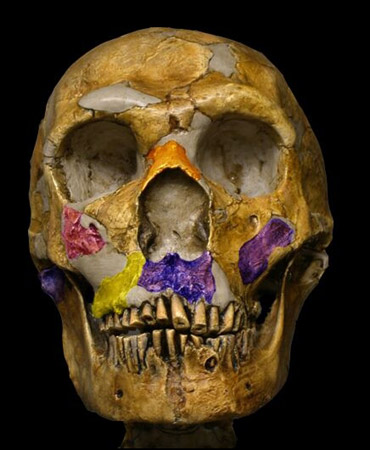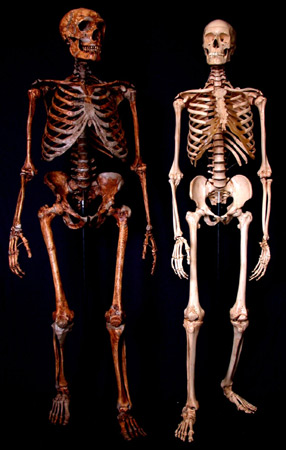Neanderthals and Humans: Perhaps They Never Met

The number of years that modern humans are thought to have overlapped with Neanderthals in Europe is shrinking fast, and some scientists now say that figure could drop to zero.
Neanderthals lived in Europe and western Asia from 230,000 to 29,000 years ago, petering out soon after the arrival of modern humans from Africa.
There is much debate on exactly how Neanderthals went extinct. Theories include climate change and inferior tools compared to those made by modern humans. Anthropologists also disagree on whether modern humans and Neanderthals are the same species and interbred.
And now, some scientists dispute whether they lived side-by-side at all in Europe.
Zero overlap?
The overlap figure shrank in February with new research by Paul Mellars of Cambridge University based on improved carbon-14 dating to show that modern humans started encroaching from Israel upon Neanderthal territory in the Balkans 3,000 years sooner than previously thought. This rate suggests Neanderthals succumbed sooner to big climate shifts or competition from modern humans for resources and that they might have overlapped for only 1,000 years at sites in western France.
Try zero years, says anthropologist John Hawks of the University of Wisconsin-Madison.
Sign up for the Live Science daily newsletter now
Get the world’s most fascinating discoveries delivered straight to your inbox.
There is no longer any biological evidence of overlap between Neanderthals and non-Neanderthals in Europe, Hawks wrote recently in his blog. Many anthropologists are aware of this but "would like to sweep it under a rug," Hawks told LiveScience.
Lack of fossils
While a blog is not the traditional place where scientific advances are first published, Hawks is not alone in questioning conventional wisdom on this point.
William Davies, of the Center for Human Origins at the University of Southampton, recently told The Associated Press that he thinks the "dates we have relating to interaction (of Neanderthals with modern humans in Europe) will keep getting shorter."
Anthropologists ideally rely on a combination of fossil and archaeological evidence to piece together how populations of early and modern humans evolved and dispersed globally. For one key culture though, called the early Aurignacian, there are no fossils, just sophisticated jewelry and stone and bone tools that many claim could only be made by modern humans with their advanced technologies relative to Neanderthals.
A number of scientists recently have agreed that the carbon-14 dates on numerous fossils of modern humans should be shifted 2,000 to 7,000 years earlier. The recent Mellars research is one example of this work.
'Big hole'
The trouble is that this trend leaves "a great big hole" in the fossil record when it comes to the early Aurignacian, Hawks said. The only group in Europe at the right time and place to have made the jewelry and tools attributed to early Aurignacian culture is the Neanderthals, he said.
So even if Neanderthals failed to outlast modern humans, we might have to give them more credit for their handiness with tools.
Most likely, the later Aurignacian "was made by a population with genetic input from both Neandertals and modern humans from outside Europe, because the skeletal remains of later Aurignacian people have the features of both groups," Hawks says. "I would predict that the early Aurignacian people were actually more Neanderthal-like. Until we have skeletal remains, we won't know."
- Timeline of Human Evolution
- Peace or War? How Early Humans Behaved
- Scientists Build 'Frankenstein' Neanderthal Skeleton
- When Humans and Chimps Split
- How Evolution Works
- Top 10 Missing Links
Humans & Neanderthals

Robin Lloyd was a senior editor at Space.com and Live Science from 2007 to 2009. She holds a B.A. degree in sociology from Smith College and a Ph.D. and M.A. degree in sociology from the University of California at Santa Barbara. She is currently a freelance science writer based in New York City and a contributing editor at Scientific American, as well as an adjunct professor at New York University's Science, Health and Environmental Reporting Program.










